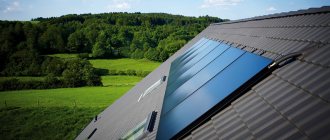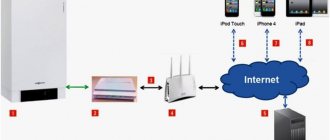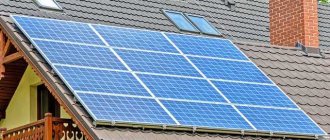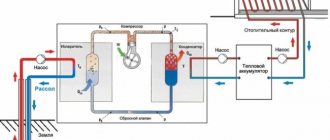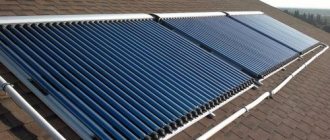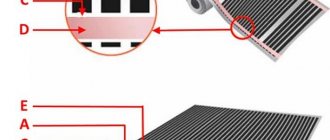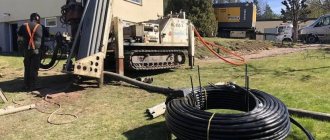The use of “green” energy supplied by natural elements can significantly reduce utility costs. For example, by arranging solar heating for a private home, you will supply low-temperature radiators and underfloor heating systems with virtually free coolant. Agree, this is already saving money.
You will learn everything about “green technologies” from our proposed article. With our help, you can easily understand the types of solar installations, the methods of their construction and the specifics of operation. You will probably be interested in one of the popular options that are actively working in the world, but are not yet in great demand here.
In the review presented to your attention, the design features of the systems are analyzed and the connection diagrams are described in detail. An example of calculating a solar heating circuit is given to assess the realities of its construction. To help independent craftsmen, photo collections and videos are included.
What is a solar collector and its operating principle?
A solar thermal collector is a technical device that is capable of converting solar energy into heat. It is used to produce hot water, which can later be used for various needs. The main difference between solar collectors and other versions of similar equipment is the principle of changing the density of water during heating. Cold masses displace the heated water flow upward, so there is no need to use additional pumping equipment.
The operating principle of the device is as follows. Solar energy is absorbed in a receiving device, which can be copper or glass surfaces of dark or black color. Such materials are characterized by good energy absorption capacity.
Solar water heaters are conveniently located on the roof, where there is plenty of space and maximum sunlight. Here, such devices do not take up useful space and do not disturb anyone. Next, the heat from the storage tank is transferred to the coolant tank. This could be water, antifreeze or another liquid that is used in the heating system.
Operating principle of the solar collector
In most cases, a mixture of 40% glycol and 60% distilled water is used. The coolant, which is heated to a certain temperature, is supplied to the radiators through a piping system.
The direction of water movement in the system can change thanks to the mixer. Cooled and warm water constantly replace each other. This natural circulation occurs due to the expansion of warm water, which rises, displacing cold water into the heating tank.
This heating system must be equipped with a thermal insulation layer at least 25-30 cm thick, which will ensure its efficient and stable operation. It is better to use a rectangular tank as a storage tank for coolant. A backup heating element can be located here. It will automatically come into operation when weather conditions are created that are not conducive to heating the coolant to the required temperature.
A solar collector is a device for converting solar energy into thermal energy
Methods for connecting to the heating system
Since solar-powered devices cannot provide a stable, round-the-clock energy supply, a system that is resilient to these shortcomings is needed.
For central Russia, solar devices cannot guarantee a stable flow of energy, so they are used as an additional system. Integration into an existing heating and hot water system is different for a solar collector and a solar battery.
Scheme with water collector
Depending on the purpose of using the heat collector, different connection systems are used. There may be several options:
- Summer option for hot water supply
- Winter option for heating and hot water supply
The summer option is the simplest and can even be done without a circulation pump, using the natural circulation of water.
The water is heated in the solar collector and, due to thermal expansion, enters the storage tank or boiler. In this case, natural circulation occurs: cold water is sucked out of the tank instead of hot water.
In winter, at subzero temperatures, direct heating of water is not possible. Special antifreeze circulates through a closed circuit, ensuring heat transfer from the collector to the heat exchanger in the tank
Like any system based on natural circulation, it does not work very efficiently, requiring compliance with the necessary slopes. In addition, the storage tank must be higher than the solar collector. In order for the water to remain hot for as long as possible, the tank must be thoroughly insulated.
If you really want to achieve the most efficient operation of the solar collector, the connection diagram will become more complicated.
To prevent the collector from turning into a cooling radiator at night, it is necessary to stop the water circulation forcibly
Non-freezing coolant circulates through the solar collector system. Forced circulation is provided by a pump controlled by a controller.
The controller controls the operation of the circulation pump based on the readings of at least two temperature sensors. The first sensor measures the temperature in the storage tank, the second - on the hot coolant supply pipe of the solar collector.
As soon as the temperature in the tank exceeds the temperature of the coolant, the controller in the collector turns off the circulation pump, stopping the circulation of coolant through the system. In turn, when the temperature in the storage tank drops below the set value, the heating boiler turns on.
Systems with vacuum tubes have become a new word and an effective alternative to solar collectors with coolant, the operating principle and design of which we suggest familiarizing yourself with.
Scheme with solar battery
It would be tempting to apply a similar scheme for connecting a solar battery to the electrical grid, as is implemented in the case of a solar collector, accumulating the energy received during the day. Unfortunately, for the power supply system of a private home, it is very expensive to create a battery pack of sufficient capacity. Therefore, the connection diagram looks like this.
When the power of the electric current from the solar battery decreases, the ATS unit (automatic switching on of a reserve) ensures the connection of consumers to the general power grid
From the solar panels, the charge is supplied to the charge controller, which performs several functions: ensures constant recharging of the batteries and stabilizes the voltage. Next, the electric current is supplied to the inverter, where 12V or 24V direct current is converted into single-phase alternating current 220V.
Alas, our electrical networks are not suitable for receiving energy; they can only work in one direction from source to consumer. For this reason, you will not be able to sell the extracted electricity or at least make the meter spin in the opposite direction.
The use of solar panels is advantageous in that they provide a more versatile type of energy, but at the same time they cannot compare in efficiency with solar collectors. However, the latter do not have the ability to store energy, unlike solar photovoltaic batteries.
Image gallery
Photo from
Solar power plants for home heating
The process of installing solar panels on the roof
Self-installation of the device on the garage roof
Homemade electrical appliance for solar heating
You will find everything about the options for organizing heating of a private house using solar panels in this article.
Advantages and disadvantages of solar collectors for heating water
In summer, solar collectors are able to fully provide the house with hot water. In the off-season, such an alternative heating system can reduce the load on the gas boiler, which will reduce gas consumption, while reducing financial costs.
The collector acts as an additional source of free heat, thereby reducing dependence on gas. In the summer, there will be no financial costs required to obtain hot water.
You can provide your home with hot water in the summer using solar collectors
Installation of a solar collector does not require obtaining a permit. When choosing equipment, you should study in detail all available information and consult with a knowledgeable seller. The installation of the system must be entrusted to a specialist or done independently if you have certain skills and abilities in the field of plumbing. The average lifespan of the system is about 15 years. During this time, you can use free solar heat for your own needs.
The disadvantages of such a system include the large financial costs that will need to be incurred when purchasing solar collectors. The average cost of one element is $500-1000. A system consisting of two collectors and assembled on a turnkey basis will cost between $2300-3000.
The intensity of solar energy differs at different times of the year, so solar collectors cannot be used as the only source of heat. For the system to operate, you will need a storage tank, the purchase of which will increase the cost of installing a solar water heating system.
Performance of solar systems in winter
No one doubts the use of ecosystems in summer. But how solar panels work in winter remains a sore point among users.
It is safe to say that solar collectors work in winter. Of course, their efficiency decreases and an additional heating source is required. After all, in winter the sun also shines clearly, and on cloudy days the absorber collects reflected sunlight passing through the clouds.
The performance of the battery also depends on its angle of inclination relative to the horizon. It is set to make the most of the light during the short winter day.
Snowfalls significantly impair the operation of the collector, so cleaning it from snow accumulation is the main condition for operation in winter. Snow is the enemy of a flat device. Vacuum batteries tend to heat the entire flask and self-clean. But sometimes they have to be cleaned forcibly.
Solar collectors for home heating: types of installations
By design, solar collectors can be flat or vacuum. The latter option is a more common type, which is characterized by ease of installation, high efficiency, and the ability to provide the required amount of heat to the entire house. A vacuum solar collector for heating a house, the price of which exceeds the cost of a flat product, is represented by a complex design that can be used to fully heat a room and heat water in any season of the year.
Where will solar installation be most effective?
When it comes to replacing heating with a solar system, you need to take into account a number of factors that affect its efficiency.
First, you need to choose the right type of solar system. In this matter, you should take into account the area of the room and its purpose. Most often this is a private house in which a family of 4-5 people lives.
Secondly, carefully calculate your heat needs based on maximum consumption during the cold season. Compare these figures with the amount of energy generated per square meter. m solar installation. All that remains is to calculate the area of the solar structure that can cope with the heating of a particular room.
The resulting value will become the main factor in determining the location of the system. Typically, household owners prefer to use the roof or wall of the house. Rarely use the adjacent area or the roof of the garage. Sometimes special stands are built for mounting the installation.
The construction of special stands for the installation of solar systems allows for the most convenient placement of them in the local area
It is important that nothing prevents the free penetration of sunlight onto the light-absorbing surface. You need to choose a south, south-east or south-west wall or part of the roof
Having decided where the solar panels will be placed, it is necessary to carry out preliminary preparation of the home:
- Free up space. Cut down excess plantings if they are in the way.
- Strengthen the roof. Here we must not forget about the weight of the proposed structure.
- Additional insulation of the building. After all, it makes no sense to heat the street.
Thirdly, you need to decide whether to buy or build a heating system yourself. It all depends on financial capabilities and the desire to spend time on manufacturing the structure.
Having chosen the second option, you need to understand the operating principle of the desired system in order to assemble everything correctly.
Design features of a flat solar collector
The most popular option, according to numerous reviews, is a flat-type solar collector, which you can make yourself. This system is effective for organizing hot water supply during the warm season. In winter, the efficiency of the device is very low.
Flat type solar collector. Possibility of manufacturing on your own, ease of installation and maintenance
The collector body has a flat square or rectangular shape. It is made of metal or other material with a high thermal conductivity coefficient. The product is coated with dark paint to improve absorbent properties. Inside the body there is a plate in which there is a coil made of a small-section copper tube. The coolant circulates through the tubes. To minimize heat loss, thermal insulation material is laid inside the housing.
To prevent debris from penetrating into the device body, it is closed on top with a glass or polycarbonate lid, which can increase heating. For the collector to operate efficiently, it must be periodically wiped to remove dirt and dust.
It is recommended to install a flat solar collector in the southern regions, where this option is characterized by the best price and efficiency indicators. Such a device is distinguished by its self-cleaning ability, high efficiency in summer and low cost.
However, flat collectors are characterized by significant heat losses, which arise due to the design features of the device. Such a system has low efficiency in the spring-autumn period. The structure is characterized by high windage, which causes the risk of damage to its elements during operation.
Absorber, the most important part of the system
The part of the solar collector that receives, accumulates and transfers heat to the coolant is called an absorber. The efficiency of the entire system depends on this element.
This element is made of copper, aluminum or glass, followed by coating. The efficiency of the absorber depends more on the coating than on the material from which it is made. Below, in the photo, you can see what kind of coatings there are and how effectively they can absorb heat.
The description of the system indicates the maximum possible absorption of solar energy incident on the absorber. "α" is the maximum possible absorption percentage. "ε" is the percentage of reflected heat.
By type of structure
Absorbers also differ in the type of device; now there are only two types:
Feather
- are arranged as follows. The plates connect tubes with coolant to each other. The tubes themselves can be interconnected into one system in several ways. This is a simple type of absorber that you can make yourself.
Cylindrical
— in this case, the coating is applied to the glass surface of the flask and used in vacuum manifolds. Thanks to this device, the heat is concentrated more precisely in the center of the tube where the heat extractor, or rod, is located. This system operates with higher efficiency than the pen system.
Solar air collector for heating: product features
Air solar collectors use air as a heating medium for heating. The device can be made in two versions: in the form of a flat corrugated or perforated panel or a system of metal pipes.
The simplest option is a flat absorber, consisting of a panel and a tube with an inlet and outlet pipe. All elements are located in a box, the back and side walls of which are covered with thermal insulation. The panel is made of copper or aluminum and painted black. It is covered with a transparent protective surface made of glass, plastic or polycarbonate.
Operating principle of solar air collector
The air entering the panel is heated by contact with the metal. The ribs on the surface of the product increase heat transfer. For maximum efficiency, the structure should be installed on the south side of the house, with high-quality insulation. The system can be organized with natural or forced coolant circulation. The last option involves installing a fan.
A system with natural circulation is used extremely rarely, which is associated with the slow movement of air masses, resulting in significant heat losses. Solar Fox air solar collectors can operate at temperatures as low as 25 °C, while for a water solar system the optimal value is 45 °C. Such structures can only be used for air heating of the house. Collectors are not able to heat water. The devices are characterized by low efficiency, have very impressive dimensions, but have a simple design, are easy to install and are affordable.
The thermal conductivity of air is significantly lower than these indicators of water, which affects the efficient operation of the system. To avoid heat loss, all butt joints must be carefully insulated. Despite the existing shortcomings, the air solar collector copes well with the task of heating indoor air with a temperature difference between inside and outside of 15-17 ° C.
Impact of precipitation
How solar panels perform in winter depends on their type.
Vacuum panels, due to their design and larger angle of inclination relative to the ground, can also work in diffused light, in cloudy weather. When covered with snow, flat panels do not work at all, and the efficiency of the vacuum panel is reduced by 10%-15%. The same rule applies to frosting. Ice does not interfere with the operation of the collector, because it is transparent and does not interfere with the penetration of radiation to the receiving surface.
Temperature fluctuations do not have a significant effect on the efficiency level. The top layer of vacuum tubes does not heat up or cool down; they reliably conserve heat. A flat-plate collector releases approximately 5% of the heat.
Rain and hail cause more damage to flat units than to vacuum units. But vacuum ones are more difficult to clean - snow accumulates on them and ice forms.
Requirements for materials for the manufacture of a homemade solar collector
To make the frame of a solar collector for heating with your own hands, plywood, wooden beams, OSB boards or other similar options are used. As an alternative, you can use an aluminum or steel profile with inserts made of similar materials, which will give the structure strength and reliability. However, such a case will have a high cost.
Materials must meet the requirements for structures located outdoors. Since the average service life of a solar collector is 20-30 years, it is necessary that the materials have high performance characteristics that will remain unchanged throughout the entire service life of the installation.
Wood for the body must be treated with water-polymer compositions and coated with paint and varnish emulsions. The steel profile must be reliably protected from corrosion.
To make a solar collector with your own hands, the simplest materials are suitable.
To make a heliostat absorber with your own hands, you use available materials. The coil can be made from rigid PVC pipe with fittings, flexible HDPE pipe, bent copper or metal tube. The heat exchanger of an old refrigerator is suitable for the absorber. The element can also be made from aluminum cans or plastic bottles. The main selection criterion is the thermal conductivity of the material.
To prevent heat loss, the housing should be insulated on all sides. For these purposes, mineral wool or polystyrene foam is mainly used. The foil version of the insulation has proven itself well, which will provide not only thermal insulation, but also reflection of the sun's rays from the surface.
The heat exchanger is covered with a protective surface, which can be tempered glass or monolithic polycarbonate. The material should have a grooved rather than smooth surface.
Review of solar water heaters on the market: manufacturers and models
Such water heaters are widely used in practice in many European countries: Israel, Turkey, Saudi Arabia, China, etc. Since the distribution of this type of product is actively increasing, the number of companies that manufacture solar water heaters and provide services for their installation and installation also increases accordingly. service.
Below is a list of top manufacturers that have entered the global market:
- Sunrain Solar Energy Co., Ltd. – China has a full production cycle of this equipment and their components.
- Viessmann - Germany, produces two models of heaters: Vitosol 200 and Vitosol 300. The difference lies in the different structure of the heating unit.
- Buderus - Germany. The model range is presented in three possible versions - SKR6, SKR12, SKR21.
- Ariston - Italy. The KAIROS VT vacuum manifold model is available in two types - for 15 or 20 tubes.
- Ferroli - Italy. The Ecotube collector is available in one model.
- Vaillant - Germany. Their models are available in 6 or 12 tubes, which can be formed into blocks to increase productivity.
By purchasing products from world-famous manufacturers, you can be confident in the quality of the product and the guarantees that are given for the equipment itself and its further maintenance. The price, accordingly, will also be at the same level.
In any case, when choosing a solar water heater, you need to pay attention to the following technical parameters:
- optical efficiency;
- heat loss coefficients;
- collector area;
Using these indicators, you can evaluate the energy efficiency of the water heater. If such information is missing, then it is impossible to evaluate the performance of the purchased equipment and all pitfalls will be discovered directly during operation and after certain investments, which may simply be unjustified.
https://youtube.com/watch?v=uYl89R0tco0
Options for creating an air solar collector with your own hands
Making a traditional air solar collector for heating your home with your own hands begins with creating a frame from wooden boards. The back and end walls should be insulated with mineral wool. The housing is fixed to the wall. All gaps must be insulated with foam. On the sides there are holes for pipes for the entry and exit of air masses. External elements are securely wrapped with heat-insulating material.
A perforated metal sheet made of aluminum, which is characterized by high thermal conductivity and low cost, is used as an absorber. To increase selective qualities, it is coated with black paint. A sheet of glass or polycarbonate is placed on top.
Homemade air solar collector from corrugated pipe
The absorber can be made of rectangular water pipes, which are installed on an aluminum sheet and fixed to it using mounting tape and self-tapping screws. The back wall of the wooden case is insulated with mineral wool, and the side walls with expanded polystyrene. The pipes are painted black and covered with a sheet of tempered glass or polycarbonate.
An even simpler design is made from corrugated sheets. The frame is made of wooden blocks. An exit hole is made in the bottom. Corrugated sheeting with many holes throughout the entire area of the product is laid on the beam, which will ensure air flow.
A good solution is to build an air collector on the window. This is a fairly effective option that allows you to heat the room well. The frame is made of aluminum frames and attached to the window in the form of a mosquito net. The rear wall is made of aluminum sheet, in which holes are made in the lower (for intake of cold air) and in the upper (for removal of warm air) parts. The role of an absorber can also be performed by black foil, which is covered with a protective PVC film.
Efficiency in winter
Is it effective to heat a house with solar collectors in winter?
Well, now let's see how different types of solar collectors work in winter conditions. Let us recall that opponents of the introduction of such installations put forward the following arguments:
- Covering the panel with snow: this problem is relevant only for flat plate collectors. As practice has shown, snow is retained on the tubes of vacuum installations only in those rare cases when, due to special weather conditions, frost forms on their surface. If during a snowfall even a slight wind blows (from 3 m/s), the panel will definitely remain clean.
- Because the collector is surrounded by cold air, all the heat from the collector is lost: again, this argument only applies to flat plate collectors. Indeed, in winter the productivity of such an installation decreases fivefold compared to summer. In more advanced vacuum models, a layer of vacuum allows you to save up to 95% of the absorbed heat. The most modern models can bring water to a boil even in severe frost.
- The collector can easily be damaged by hail: in the factory, collectors are made of high-strength materials. On the Internet you can find videos taken during impact tests of panels. The collectors are fired with steel balls and it is easy to see that they withstand the blow very well.
As you can see, solar collectors are quite functional in winter. Although, of course, their productivity is noticeably reduced in comparison with the summer period.
Solar collector for home heating: reviews and recommendations for choosing a device
When choosing a solar collector, you should take into account some nuances. Flat models are more durable than other varieties. However, such structures are not suitable for repair. A minor breakdown can damage the entire absorption system, which leads to the cost of purchasing a new one. You can save money by making a flat solar water heater with your own hands, which heats the coolant 30-40 °C above the ambient temperature.
Vacuum solar heating systems are very sensitive to external influences and are more susceptible to damage, which is due to the fragility of hollow pipes. However, if one of the flasks fails, it can be replaced with a new one. This collector is much more efficient in winter than the flat version, since it provides heating over a wider range and is able to maintain the temperature for a long time.
The performance of a vacuum manifold depends on the size of the tubes. The shorter they are, the less thermal energy generation. The best option is a system with several flasks 2 m long and 6 cm wide. To ensure effective thermogenesis, a straight or U-shaped insert should be located in the inside of the flask.
Air options have a simple design, rarely require repairs, and can withstand very low temperatures. Their service life exceeds the service life of other systems. However, they do not heat the room very well.
It is important to choose the right location to install the system. A DIY solar water heater must be placed on the south side or with a deviation of 30° from it. Measures must be taken to remove precipitation during the winter period. The device can be positioned vertically, which will eliminate the problems associated with clearing snow from the collector. However, this situation will negatively affect the efficiency of the heater.
Ways to use solar energy
Methods for using the energy of the celestial body are not innovative technologies; solar heat has been used for a long time and very successfully. However, this applies mainly to Australia, some countries in Europe, America and the southern regions, where alternative energy can be obtained throughout the year.
Some northern regions lack natural radiation, so it is used as an additional or backup option.
The intermediaries between the sun's rays and the energy-generating mechanism are solar panels or collectors, which differ in both purpose and design.
Batteries accumulate solar energy and allow it to be used to power household electrical appliances. They are panels with photocells on one side and a locking mechanism on the other. You can experiment and assemble the battery yourself, but it’s easier to buy ready-made elements - the choice is quite wide.
Solar systems (solar collectors) are part of the heating system of a house. Large thermally insulated boxes with coolant, like batteries, are mounted on raised panels facing the sun or roof slopes.
It is a mistake to believe that absolutely all northern regions receive much less natural heat than southern ones. Suppose there are many more sunny days in Chukotka or central Canada than in Great Britain located to the south
To increase efficiency, the panels are placed on dynamic mechanisms reminiscent of a tracking system - they rotate following the movement of the sun. The energy conversion process occurs in tubes located inside the boxes.
The main difference between solar systems and solar panels is that the former heat the coolant, and the latter accumulate electricity. It is possible to heat the room using photocells, but the design schemes are irrational and are suitable only for those areas where there are at least 200 sunny days a year.
Diagram of a heating system with a solar collector connected to a boiler and a backup source of electricity (for example, a gas boiler) running on traditional fuel (+)
Method for increasing productivity
Usually, after experimenting with a small number of solar modules, private home owners go further and improve the system in various ways.
The easiest way is to increase the number of modules involved, accordingly, attract additional space to accommodate them and purchase more powerful related equipment
What to do if there is a shortage of free space? Here are some recommendations for increasing the efficiency of a solar station (with photocells or collectors):
Changing the orientation of modules. Moving elements relative to the position of the sun. Simply put, installing the bulk of the panels on the south side. During long daylight hours, it is also optimal to use surfaces facing east and west.
Tilt angle adjustment. The manufacturer usually indicates which angle is most preferable (for example, 45º), but sometimes during installation it is necessary to make adjustments taking into account geographic latitude.
Correct choice of installation location. The roof is suitable because it is most often the highest plane and is not obscured by other objects (for example, garden trees). But there are even more suitable areas - rotating sun tracking devices.
When the elements are positioned perpendicular to the rays of the sun, the system works more efficiently, but on a stable surface (for example, a roof) this is only possible for a short period of time. To increase this, practical tracking devices have been invented.
Tracking mechanisms are dynamic platforms that rotate with their planes following the sun. Thanks to them, generator productivity increases by about 35-40% in summer, and by 10-12% in winter.
The big disadvantage of tracking devices is their high cost. In some cases, it does not pay off, so there is no point in investing in useless mechanisms.
It is estimated that 8 panels is the minimum number at which the costs will be justified over time. You can use 3-4 modules, but under one condition: if they are directly connected to the water pump, bypassing the batteries.
Just the other day, Tesla Motors announced the creation of a new type of roof - with integrated solar panels. Elon Musk said that the modified roof will be cheaper than a conventional roof with collectors or modules installed on it.
About the vacuum accumulator
A solar water heater operating in this way has a vacuum collector in its structural part.
Its operating principle is similar to that of a thermos. It consists of 2 tubes, between which there is a vacuum. The glass tube is located outside and the copper tube inside, the second is sealed and liquid circulates in it. Vacuum and copper together have the property of heating water even at a temperature of 30. The steam, rising, provides the heat sink with energy, and then the temperature is redistributed among the coolants. After this, the liquid, cooling, is directed downward, and the working cycle is repeated.
The main advantage of using a battery is the replacement of structural elements without repairs, which means ease of maintenance. Since in such systems the coolant passes directly, it is unlikely to be possible without an artificial shutdown. But the efficiency reaches almost 80%.
